mobile View, to the German Version tap the flag


- Cooperative Republic of Guyana
- democratic presidial republic
- own name: Cooperative Republic of Guyana
- in colonial times sometimes used name for that country: "Demerara"
• Flags
• Historical Flags
• Meaning/Origin of the Flag
• Coat of Arms
• Meaning/Origin of the Coat of Arms
• Map
• Numbers and Facts
• History
• Origin of the Country's Name
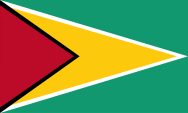
National flag,
ratio = 3:5,
Source, by:
Wikipedia (D)





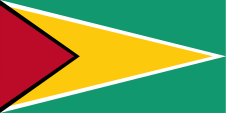
Merchant flag and official flag at sea,
ratio = 1:2,
Source, by:
Wikipedia (D)




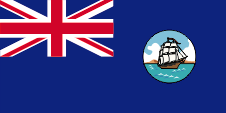
1875–1906,
Flag of the government (state flag),
ratio = 1:2,
Source, by:
Wikipedia (D)



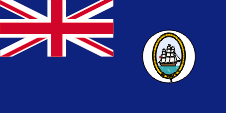
1906–1919,
Flag of the government (state flag),
ratio = 1:2,
Source, by:
Wikipedia (EN)



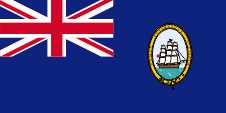
1919–1954,
Flag of the government (state flag),
ratio = 1:2,
Source, by:
Wikipedia (D)



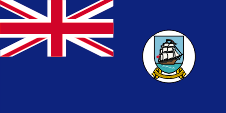
1954–1966,
Flag of the government (state flag),
ratio = 1:2,
Source, by:
Wikipedia (D)



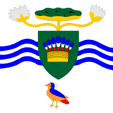
1973–1980,
Flag of the President,
ratio = 1:1,
Source, by:
Wikipedia (EN)




1980–1985,
Flag of the President,
Source, by:
By Prez001 (Own work) [Public domain],
via Wikimedia Commons




1985–1992,
Flag of the President
Source, by:
von Prez001 (Eigenes Werk) [Public domain],
via Wikimedia Commons




1992–1997,
Flag of the President,
Source, by:
By Prez001 (Own work) [Public domain],
via Wikimedia Commons




The today's flag of Guyana was introduced on 26th of may in 1966. It shows on green ground two isosceles triangles with the base on the pole site, wehere within the larger white-bordered yellow triangle lies a red black-bordered triangle. Green stands for the woods and the agriculture of the country, white for the water's riches, yellow the natural ressources, black for the endurance and red for the people's enthusiasm and willingness for sacrifice. The flag is in principle designed by the vexillologist Whitney Smith and is known for the denomination "Golden Arrow". But the original realisation has a red field without a border. The english College of Arms made the changes. Whitney Smith would with the flag initially combine the Pan-African colours (green, yellow und red), although only 30% of the population are from African origin. After the changes they are indeed contained, but now results a further peculiarity: In the flag appear now even the Garvey-Colours (red, black and green). The combination of the colours green, yellow and red in the today's flag are the Pan-African colours: Perhaps in 1900 was the beginning of the Panafrica-Movement, wich wants to emphasize the commons of all people with black skin. For the political unity of Africa stands the colour-triad green-yellow-red, wich used many african countries in their flags after the independence. The first country was Ghana in 1957. As the origin apply the colours of Ethiopia (Abessinia), the oldest independent state in Africa. The combination of the colours red, black and green is named Garvey-colours. They are those colours who created Markus Garvey in 1917 for the flag of the United Negro Improvement Association, which was striped in this colours. He was a supporter of the "Back-to-Africa"-Movement and saw in them the colours of a state of Blacks, which should be accomplished in Africa. But the colours get known in the USA and in the Caribic as the colours of the Black-Power-Movement, and get in Africa few persuasion. Nevertheless this colour-combination is sometimes named as Panafrican Colors. The colors of the flag are defined as follows: red = Pantone 032, yellow = Pantone 109, green = Pantone 355 and black. Other sources mention as Hex Code Scale: red #BE1E2D, yellow #FFC20E, green #2A936A. The first flag of the president was introduced in 1973. It was a scutcheon-flag with a green shield in the middle, who shows a plume-crest. In the following years each President had his own flag.
Source:
Die Welt der Flaggen,
Flaggen Wappen Hymnen,
Flags of the World,
Volker Preuß

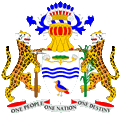
since 1966,
Coat of arms of Guyana,
Source, by:
Corel Draw 4

The coat of arms of the state was awarded on 21st of January in 1966 by queen Elisabeth II. It shows in a white blazon a sea-rose, three blue waves (standing for water-riches) and a Canje-Pheasant. The blaozon is surrounded by native symbols: the headdress (plume-crest) of a indian chief, two diamonds and two jaguars as shield holders which have sugarcane and a hoe in their claws. In the saying-ribbon below the shield the state's motto: "One People, One Nation, One Destiny".
Source:
Flaggen Wappen Hymnen

Location:
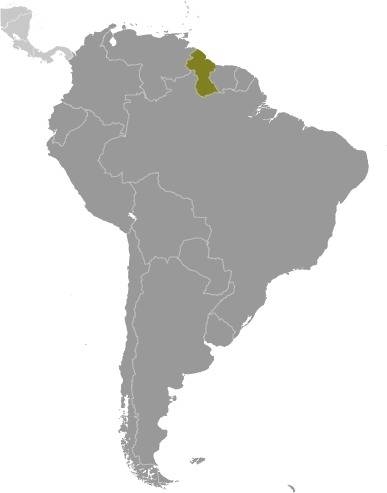
Source: CIA World Factbook
Map of the country:
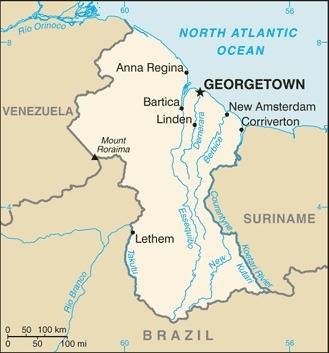
Source: CIA World Factbook

Area: 82.000 square miles
Inhabitants: 783.000 (2019), thereof 40% Indians, 29% Afro Americans and Creole, 20% Mulattos, 10% native Indians, 0,3% Europeans, 0,2% Chinese
Religions: 63% Christians, 25% Hindu, 7% Muslim, 3% Non-Religious
Density of Population: 9 inh./sq.mi.
Capital: Georgetown, 118.363 inh. (2012)
official Language: English
other Languages: Creole English, Hindi, Tamil, Urdu native Indian languages
Currency: 1 Guyana Dollar (G$, GYD) = 100 Cents
Time Zone: GMT – 4 h
Source: 1.) Wikipedia (D), 2.) Wikipedia (D)

1499 · Columbus probably discovers the coast of Guyana (but likelyer this have been Vespucci, Ojeda or de la Cosa), because of the Tortesillas Treaty (1494) is Guyana officially a Spanish colonial possession, but becames not colonized by Spain
1581 · Dutch colonization upon the river Demerara
1595 · additionally English colonization (probably upon the river Essequibo)
1595 · furthermore Dutch colonization, foundation of Stabroete (today Georgetown) and New Amsterdam, formation of the Dutch colonies Essequibo, Demerara and Berbice
1781 · British-Dutch war
1796 · in result of the losed British-Dutch war the Netherlands hade to cede a part of their colonies in Guyana to
United Kingdom, formation of British Guyana
1814 · London Treaty, the border between Dutch and British Guyana gets exactly stated
1834 · abolition of the slavery
1850–52 · potent immigration from Portugal
1928 · granting of partial internal self government
1940 · as a result of the start of the Second World War the USA establish military bases in Britisch Guyana (Atkinson Field, Makouira)
March 1953 · first constitution, granting of inner autonomy, electional victory of the Progressive People's Party (PPP, dominated by Indians), anti British agitations
9th of October in 1953 · United Kingdom declares the elections for unvalid, military intervention by the British, the parliament gets liquidated
22nd of December in 1953 · pass of the "provisional constitution"
1956 · partial re-introduction of the constitution from March 1953
1957 · electional victory of the PPP
March 1960 · first Constitutional Conference in London
1961 · electional victory of the PPP
1962 · anti British agitations
1964 · anti British agitations, declaration of the state of emergency, disputed electional victory of the PPP, however the People's National Congress (PNC, dominated by of African descent) places the premier
November 1965 · second Constitutional Conference in London
26th of May in 1966 · independence within the framework of the Commonwealth of Nations
1970 · separation from the British crown, Guyana becomes a republic, but remains in the Commonwealth
1980 · new constitution, presidial system
1982 · aggravated claims for territory from Venezuela
1992 · first undisputed free and fair elections, electional victory of the PPP
2001 · PPP election victory
2015 · APNU election victory (change of power)
2020 · PPP election victory (change of power)
Source:
Atlas zur Geschichte,
Wikipedia (D),
Discovery '97

The name "Guyana" (also Guyana, Guiana) comes probably from the Indian languages, and there exist two explanations: 1st) honorable, 2nd) lot of water.
Source:
Atlas der wahren Namen


![]()
















